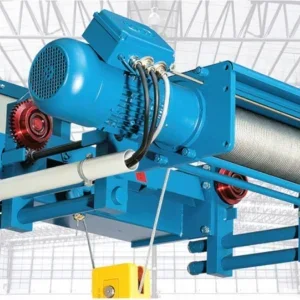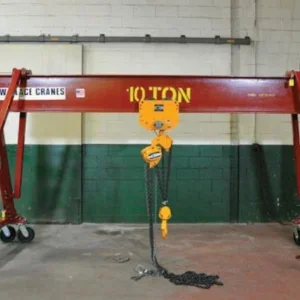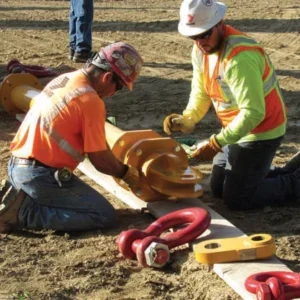All the major US and European brands are present, contesting the market, together with various Japanese brands and several indigenous manufacturers.
The election of new government in Mexico in July (outcome unknown at time of going to press) is not expected to have a significant impact on the health of the economy. That at least is the view of the Economist Intelligence Unit. It argues that the health of the US economy is the more significant factor in Mexico’s economic health, since the latter’s economic cycles are firmly tied to the former.
Jeff Brazwell, export manager of R&M Materials Handling, does not entirely agree. “I don’t think you can discount the impact of the election,” he says. “It’s still very important.” He says that Latin America is not like the US or Western Europe where a change in government is less likely to impact on economic policy.
However, Mexico’s ties to the US economy have been strengthened considerably since the signing of the North American Free Trade Agreement (NAFTA) 12 years ago. The northern region of Mexico has become an industrial belt largely geared to serving the demands of US markets. While the impact of NAFTA remains controversial, it is clear that the economy of northern Mexico has benefited from inward investment and a massive increase in exports – from $40bn in 1993 to $226bn in 2005. Most of the investment comes from the US and most of the exports go to there.
Many US manufacturers have opened plants just south of the border, taking advantage of the cheaper labour costs. The result is growth of Mexico’s maquiladora industry. A maquiladora is a company with exemptions from import duties and has entitlements to foreign ownership. Generally they import raw materials from the US, process them and re-export the finished (or partly finished) goods. Usually they are assembly plants. In 2003, there were approximately 3,000 maquiladoras employing more than a million people.
Jeff Brazwell says that it is a misconception, however, to regard the maquiladoras as the full extent of Mexican industry. “Most of out business is from indigenous Mexican companies, not maquiladoras,” he says.
A fifth of Mexico’s total manufacturing output is in the auto industry. Ford, Chrysler, General Motors and Volkswagen all assemble cars in Mexico. It is a $35bn industry that employees half a million people, including 55,000 assembly workers. However, three out of four cars built in Mexico are exported to the US and auto sales in the US have been in decline. Mexico’s automotive sector has been hit badly. Ford’s exports from Mexico, for example, fell from 235,000 units in 2000 to just 70,200 last year.
That said, Mexico’s total auto production rose 6.6% last year to 1.6 million units, reversing four years of decline, according to AMIA, the auto industry association. AMIA forecasts a further increase of about 12.5% to 1.8 million units in 2006.
Healthier still is the steel industry, which has risen strongly on the back of steel prices in the past couple of years. More than 15 million tonnes were produced in 2005, up from 14.3 million tonnes in 2004 and 13.0 million tonnes in 2003.
Mexico’s steel industry has also benefited from NAFTA. Last year Mexico exported 3.8 million tonnes of steel to the US. In pre-NAFTA years, output was only half what it is today. (Source: Iron & Steel Statistics Bureau.)
The improvement in the US economy over the past couple of years, emerging strongly form recession, has been felt in Mexico – including in its crane industry.
After three years of recession form 2002 to 2004, the crane business is now good, says Jorge Garcia-Corral. He and his brother Octavio own and manage Monterrey-based distributor Invent SA de CV. The company was founded by their father, also called Octavio, more than 50 years ago. Jorge looks after the sales and marketing while elder brother Octavio takes care of administration. They have been in the company for 25 and 28 years respectively and took over ownership when their father retired eight years ago.
Invent (an amalgamation of the Spanish words for engineering and sales) represents a range of suppliers in the crane industry, including Gorbel, Bushman, West Bend, Cattron Theimeg, Intercomp, Cleveland Tramrail and Schmalz. It has represented most of these lines for at least 10 or 15 years.
Monterrey is in the industrial northeast of Mexico. “In this part of the country the steel industry is the main consumer of hoists,” says Jorge Garcia-Corral. Not for nothing is Monterrey sometimes known as the Pittsburgh of Mexico, and R&M’s Jeff Brazwell describes it as the most keenly contested regional market in Mexico’s crane industry.
While Mexico’s economy overall grew about 3% in 2005, Garcia-Corral estimates that the crane market was up “maybe 35 or 40% after a very depressed 2004.”
He adds: “Our economy is very tied to the US economy. The US had an increase in demand, and so we did too.”
Demand in the crane industry this year is about steady on 2005, Garcia-Corral says. “No growth, but still a good level,” he says.
Official statistics are unavailable, Garcia-Corral says. “It is hard for the government to keep track of the market. There is a lot of importation, and not all of it is necessarily legal,” he says.
While Invent sells the Gorbel line of products to assembly and workstation applications, its most successful offering in the steel industry is Bushman end of line attachments, for coil handling and similar, and remote controls.
He says it only takes one big contract for a crane company to achieve leadership within the steel industry, such is the nature of these projects. Currently he puts Morris P&H at the top, although Demag and KCI Konecranes always remain key players.
For hoist sales generally, however, it is clear that Columbus McKinnon has the largest share, probably more than 50%, according to industry sources. CM has a hoist manufacturing plant close to Mexico City and has been established in the country for many years.
Morris Material Handling Inc, now part of the Konecranes empire, supplied a hot metal crane earlier this year to Minera Autlan SA de CV, a producer of manganese minerals and ferroalloys. The P&H crane was installed in a new extension to Minera Autlan’s plant in Tamos, Panuco, Veracruz and is being used for charging the melting furnace and for ladle handling.
The CMAA Class E crane is cab operated and includes P&H Smartorque variable frequency drives enclosed in an insulated air-conditioned, bridge mounted control. The 50t/20t capacity crane spans 23m and has an 18m lift height.
It was manufactured jointly by Morris in the USA with its Mexican subsidiary SPH Crane & Hoist Inc., which opened a new facility in Monterrey in 2004. Here it produces standard and heavy-duty P&H cranes, fabricated and assembled with pre-engineered components. It also carries out rebuilds of cranes, brakes and below-the-hook lifting devices.
Like Morris, the other major players also import components and assemble locally. Across the industry generally, Demag’s partner, Sistemas Hormiga S.A. de C.V., claims the position of market leader for electric overhead travelling cranes. It was founded in Mexico City in 1982 and expanded during the 1990s, with new centres opened in Guadalajara in 1991 and Monterrey in 1997. The head office moved to new premises within Mexico City in 2001 and then in 2003 and fourth outlet was opened in Querétaro.
KCI Konecranes acquired its Mexican licensee, Gruas Mexico S.A de C.V, in 2000 having previously held a 10% share of the company.
Gruas Mexico, located near Mexico City, can produce the entire range of Konecranes equipment and claims to be the market leader in heavier industrial cranes and contributes more than $20m to group sales.
While KCI Konecranes and Gruas Mexico sell direct to end users, Konecranes’ US subsidiary R&M Materials Handling sells through a network of distributors across the country and has been enjoying growing success. “We have been in Mexico actively for seven years now and have seen growth in every single year,” Brazwell says. In recent years it has seen “triple digit growth”, he says, although this year has become “a little more difficult”, he says.
“A lot of medium and big projects are waiting for the outcome of the election,” Brazwell says. With the three leading candidates each occupying a similar share in the polls, the outcome is hard to predict.
Despite this, R&M is still growing its sales this year, he says, only not as strongly as in previous years. Compared to the majors, R&M remains relatively small, but it is growing fast, says Brazwell.
Spanish crane and hoist producer GH established GH Mexicana in 1999 in the city of Puebla and now also has offices in Monterrey and Queretaro, as well as a new crane-building factory and parts warehouse in Queretaro that were just opened in June and will now house the company’s head office. Alfonso López-Roldán of GH Mexicana reports that since the company was set up, there has been a steady growth in sales to the full range of industries in Mexico, including paper mills and cement plants.
The market is also open to other players who have not set up local operations, however. For example, US crane builder Capco Crane & Hoist Inc, of Woburn, Massachusetts, won its first international contract in Mexico last year. It designed, fabricated and installed 28 bridge cranes to run on seven different freestanding runway systems in fibreglass products factory in Juarez. On completion of the four-month project, Capco sent three instructors to train more than 200 workers and managers on crane safety and proper use.
A concern for the future of Mexico’s industrial economy, however, is the impact of China, where labour is significantly cheaper. As Mexico matures as a market, increasing numbers of US companies are now looking to China instead to source products or set up factories. “The impact of China on Mexico is something to consider for the future,” Brazwell says.






